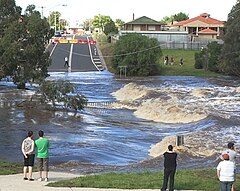2011 Victorian floods

Werribee River in flood at Werribee
|
|
| Date | 12 January – 19 April 2011 |
|---|---|
| Location | Much of central and northern Victoria including cities of Horsham, Shepparton and Swan Hill as well as towns Charlton, Rochester and Carisbrook, Beaufort, Glenorchy, Rupanyup, Murrabit Echuca, Bridgewater on Loddon, Creswick, Clunes, Kerang, Warracknabeal and Skipton. |
| Deaths | 2 confirmed dead |
| Property damage | A$ 2 billion |
High intensity rainfall between 12–14 January 2011 caused major flooding across much of the western and central parts of the Australian state of Victoria. Several follow-up heavy rainfall events including Tropical Low Yasi caused repeated flash flooding in affected areas in early February in many of the communities affected by January's floods.
Many of the towns were previously affected by floods in September 2010, however the 2011 event was more severe, affecting at least four times as many properties with thousands of evacuations being called for by the State Emergency Service. As of 18 January, more than 51 communities had been affected by the floods. A total of over 1,730 properties had been flooded. Over 17,000 homes lost their electricity supply. The floods forced VicRoads to close hundreds of roads; and train services were also disrupted. The floods devastated farms with 51,700 hectares of pasture and 41,200 hectares of field crops flooded and 6,106 sheep killed. The Victorian Employers Chamber of Commerce and Victorian Farmers Union initially estimated that damages would amount to hundreds of millions of dollars, but the Department of Primary Industries later calculated a damage bill of up to A$ 2 billion.
Kevin Parkyn, a senior forecaster with the Bureau of Meteorology said, "Victoria is experiencing one of its worst flood events in its history" after "a week in which rainfall totals have been smashed in parts of Victoria." Bureau of Meteorology senior forecaster Terry Ryan said, "It's the worst flood in western Victoria in their history as far as our records go in terms of the depth of water and the number of places affected." The Premier of Victoria, Ted Ballieu, has described it as "one of the biggest floods in the state's history."
The strongest La Niña event since 1973 which fuelled the extensive flooding across Victoria in September 2010, brought wetter conditions across eastern Australia including the 2010–2011 Queensland floods. An already soaked state had the wettest January in its recorded history in January 2011.
...
Wikipedia
